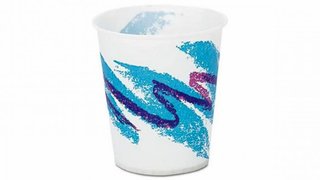The Vintage Jazz Solo Cup Pattern: A Symbol of 90s Aesthetic and Nostalgia

The 90s paper cup pattern collection, with its unmistakable teal and purple swirls, has emerged as one of the most iconic designs from the 1990s. What started being a simple, disposable cup graphic has evolved into a beloved symbol of 90s culture, evoking nostalgia and memories of a simpler time. Though it was originally created as being a functional design for fast food, cafeterias, and takeout cups, the Jazz pattern has since transcended its utilitarian roots and be a piece of vintage Americana.
The Birth of the Jazz Pattern
The Jazz pattern has been available since 1991 by Gina Ekiss, a designer for the Sweetheart Cup Company (later acquired by Solo). The company tasked Ekiss with creating a fresh, modern design because of its line of disposable cups and containers. The teal and purple wave motif was created out of a desire to create something bold and dynamic, reflective of the trends with the late 80s and early 90s.

This simple yet energetic pattern, consists of abstract swooshes that resembled brushstrokes, perfectly encapsulated the essence with the era. It was trendy and youthful, embodying the bold aesthetics in the time. Despite its modest beginnings, the Jazz design would soon become ubiquitous across the United States, available on disposable cups, plates, and even junk food packaging.
Why the Jazz Pattern Stood Out
At first glance, the Jazz design seems simple—just a teal wave intersected with a purple stroke—but its uniqueness lies in its minimalist yet expressive nature. The design's color palette, featuring its soft teal and striking purple, felt contemporary and fresh, capturing the style sensibilities in the early 90s. Abstract patterns, geometric shapes, and bold color contrasts were accepted, and the Jazz pattern aligned perfectly with your trends.
The design was non-specific and abstract, so that it is easy to adapt for a number of products. This helped it spread quickly across different industries—from hospital cafeterias to fast-food joints to office break rooms. But while the design was everywhere, it didn’t initially receive much attention. It was only after its gradual disappearance inside late 90s that individuals started recognizing its cultural significance.
A Pop Culture Phenomenon: From Utility to Nostalgia
As the 2000s rolled in and design trends shifted, the once-ubiquitous Jazz pattern slowly disappeared from public spaces. Yet, as frequently happens, the absence of something beloved sparked a wave of nostalgia for many who grew up seeing the pattern inside their daily lives. By the 2010s, the Jazz Solo cup had become a symbol of 90s nostalgia, as people reflected for the era’s unique aesthetics and carefree spirit.
The pattern's resurgence was particularly fueled by the rise of retro trends in pop culture. As people began to romanticize the 1990s, the Jazz cup emerged as being a shorthand for that decade, bringing back memories of faculty lunches, trips, and casual parties. This design, once considered disposable, became a beloved part in the collective memory of the generation.
The Resurgence in the Jazz Pattern in Contemporary Culture
Today, the Jazz pattern makes a surprising comeback. While it’s don't mass-produced on disposable products, it's found new life popular, home decor, and graphic design. Artists and designers have embraced the retro appeal in the Jazz pattern, incorporating its teal and purple swirls into clothing, phone cases, furniture, plus more.
Online retailers and independent artists on platforms like Etsy and Redbubble now sell Jazz-themed merchandise, from T-shirts and hoodies to skateboards and tote bags. The pattern has become synonymous with "vaporwave" culture, which celebrates the aesthetics of 90s and early internet culture through nostalgic and surreal visuals. Its abstract, almost futuristic look fits perfectly in this niche, further cementing the look’s place in modern pop culture.
Additionally, collectors and enthusiasts have created a growing community centered around preserving and celebrating the original Jazz cup designs. Whether it’s through collecting vintage cups or recreating the pattern in digital art, the Jazz design continues to captivate people who find themselves drawn to its iconic look.
Why the Jazz Pattern Endures
The enduring appeal of the Jazz Solo cup pattern might be attributed to several factors. First, its association with a specific time and place—especially the 1990s—evokes a strong sense of nostalgia. For many, it brings back memories of youth, family outings, or perhaps the excitement of your fast-food meal, wrapped in a disposable, colorful world that's so characteristic with the era.
Second, the pattern’s design is timeless in its simplicity. The abstract swooshes feel both modern and classic, combining energy which has a minimalist palette containing proven to be surprisingly versatile. Despite its intended use being a functional, everyday product, the Jazz design has retained a unique feeling of style and coolness that resonates with today’s design-conscious consumers.
Finally, the Jazz pattern represents a cultural shift. It’s a design that, at its core, stands as a reminder of an era when disposable culture, bold colors, and abstract designs were embraced and celebrated. The Jazz cup’s revival in retro fashion, art, and decor speaks to a bigger trend of appreciating overlooked objects from the past and finding beauty within the everyday.
Conclusion
The vintage Jazz Solo cup pattern is becoming more than just a design on the disposable cup. It’s a cultural artifact, an item of 90s nostalgia, plus a symbol from the era's bold, expressive design trends. As the pattern is constantly on the inspire new generations of artists and designers, its legacy being a beloved and iconic section of pop culture seems poised to pass through well into the future. Whether the thing is it like a symbol of a simpler time or as being a timeless design, the Jazz pattern holds a particular place within the hearts of many, proving that perhaps the most unexpected objects could become lasting cultural icons.
